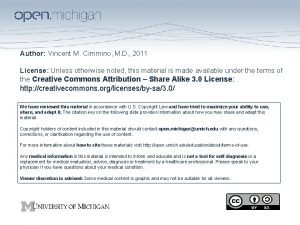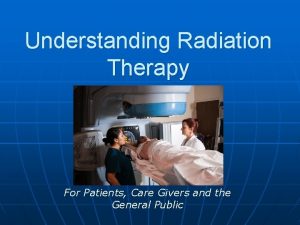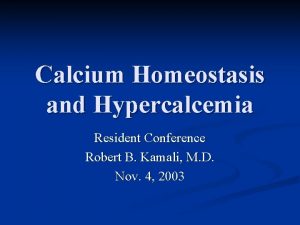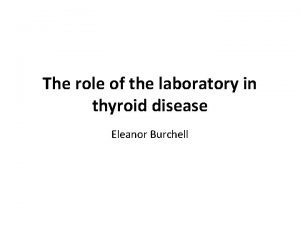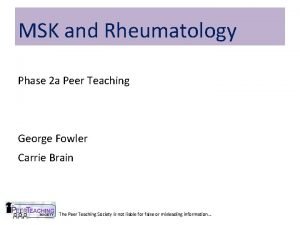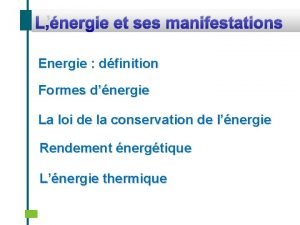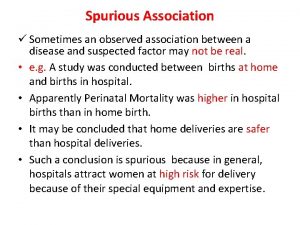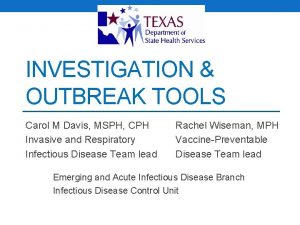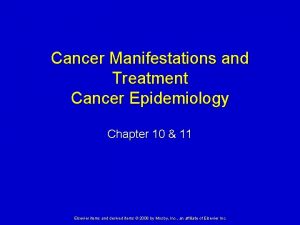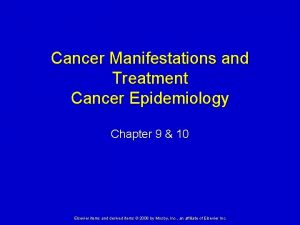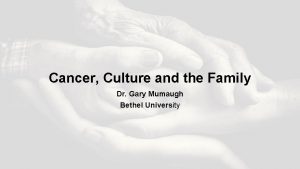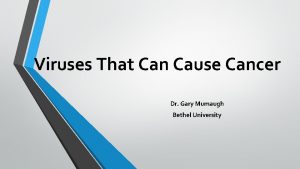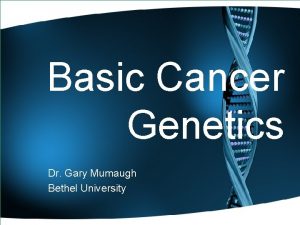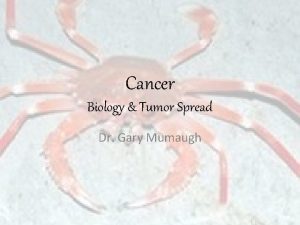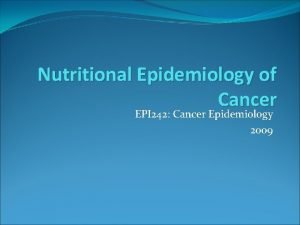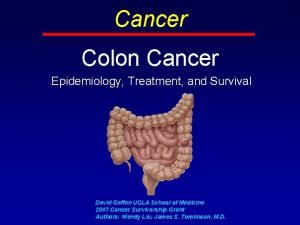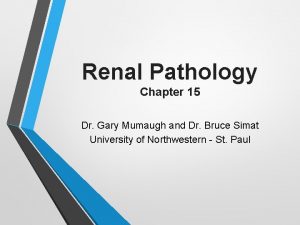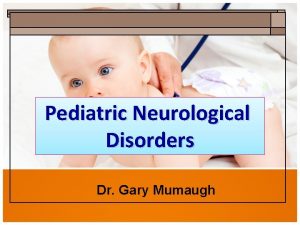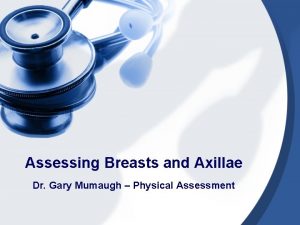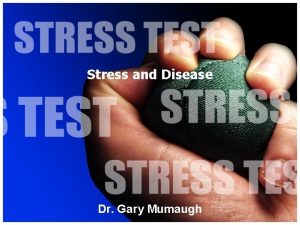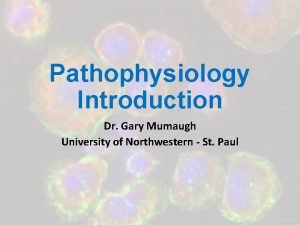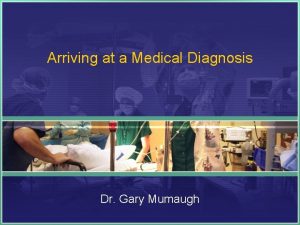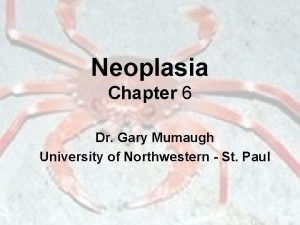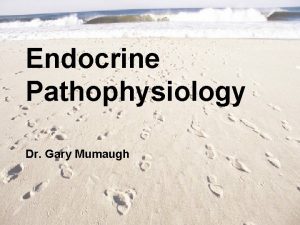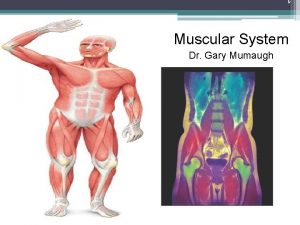Cancer Epidemiology Manifestations and Treatment Dr Gary Mumaugh





























- Slides: 29

Cancer Epidemiology, Manifestations, and Treatment Dr. Gary Mumaugh

Environmental Risk Factors • Tobacco – Multipotent carcinogenic mixture – Linked to cancers of the lung, lower urinary tract, aerodigestive tract, liver, kidney, pancreas, cervix uteri – Linked to myeloid leukemia

Environmental Risk Factors • Ionizing radiation – Emission from x-rays, radioisotopes, and other radioactive sources – Exposure causes cell death, gene mutations, and chromosome aberrations – Bystander effects – Poor gene repair – Changes in gap junction intercellular communication

Environmental Risk Factors • Ultraviolet radiation – Causes basal cell carcinoma, squamous cell carcinoma, and melanoma – Principal source is sunlight – Ultraviolet A (UVA) and ultraviolet B (UVB) – Promotes skin inflammation and release of free radicals

Environmental Risk Factors • Alcohol consumption – Risk factor for oral cavity, pharynx, hypopharynx, larynx, esophagus, and liver cancers – Cigarette/alcohol combination increases a person’s risk

Environmental Risk Factors • Sexual reproductive behavior – Carcinogenic types of human papillomavirus – High-risk HPV

Environmental Risk Factors • Physical activity – Reduces cancer risk • Decreases insulin and insulin-like growth factors • Decreases obesity • Decreases inflammatory mediators and free radicals • Increased gut motility

Environmental Risk Factors • Occupational hazards – Substantial number of occupational carcinogenic agents • Asbestos • Dyes, rubber, paint, explosives, rubber cement, heavy metals, air pollution, etc. • Radon

Environmental Risk Factors • Electromagnetic fields – Carcinogenic? • Are they, or aren’t they?

Environmental Risk Factors • Diet – Xenobiotics • Toxic, mutagenic, and carcinogenic chemicals in food • Activated by phase I activation enzymes • Defense mechanisms – Phase II detoxification enzymes • Examples – Compounds produced in the cooking of fat, meat, or proteins – Alkaloids or mold by-products

Environmental Risk Factors • Obesity – Correlates with the body mass index (BMI) – Adipose tissue is active endocrine and metabolic tissue

Environmental Risk Factors • Obesity – In response to endocrine and metabolic signaling, adipose tissue releases free fatty acids • Increased free fatty acids gives rise to insulin resistance and causes chronic hyperinsulinemia • Correlates with colon, breast, pancreatic, and endometrial cancers

Clinical Manifestations of Cancer • Pain – Little or no pain is associated with early stages of malignancy – Influenced by fear, anxiety, sleep loss, fatigue, and overall physical deterioration – Mechanisms • Pressure, obstruction, invasion of sensitive structures, stretching of visceral surfaces, tissue destruction, and inflammation

Clinical Manifestations of Cancer • Fatigue – Subjective clinical manifestation – Tiredness, weakness, lack of energy, exhaustion, lethargy, inability to concentrate, depression, sleepiness, boredom, and lack of motivation

Clinical Manifestations of Cancer • Fatigue – Suggested causes • Sleep disturbance, biochemical changes from circulating cytokines, secondary to disease and treatment, psychosocial factors, level of activity, nutritional status, and environmental factors

Clinical Manifestations of Cancer • Syndrome of cachexia – Most severe form of malnutrition – Present in 80% of cancer patients at death – Includes: • Anorexia, early satiety, weight loss, anemia, asthenia, taste alterations, and altered protein, lipid, and carbohydrate metabolism

Cachexia

Clinical Manifestations of Cancer • Anemia – A decrease of hemoglobin in the blood – Mechanisms • Chronic bleeding resulting in iron deficiency, severe malnutrition, medical therapies, or malignancy in blood-forming organs

Clinical Manifestations of Cancer • Leukopenia and thrombocytopenia – Direct tumor invasion to the bone marrow causes leukopenia and thrombocytopenia – Chemotherapy drugs are toxic to the bone marrow • Infection – Risk increases when the absolute neutrophil and lymphocyte counts fall

Clinical Manifestations of Cancer • Paraneoplastic syndromes – Symptom complexes that cannot be explained by the local or distant spread of the tumor or by the effects of hormones released by the tissue from which the tumor arose

Cancer Treatment • Chemotherapy – Use of nonselective cytotoxic drugs that target vital cellular machinery or metabolic pathways critical to both malignant and normal cell growth and replication – Goal • Eliminate enough tumor cells so the body’s defense can eradicate any remaining cells

Cancer Treatment • Chemotherapy – Compartments 1: cells undergoing mitosis and cytokinesis 2: cells capable of entering the cell cycle in the G 1 phase 3: cells not dividing or that have irreversibly left the cell cycle – Cells in compartment 3 will die a natural death

Chemotherapy • • • Single-agent chemotherapy Combination chemotherapy Principle of dose intensity Therapeutic index Neoadjuvant chemotherapy

Chemotherapy

Cancer Treatment • Ionizing radiation – Goals • Eradicate cancer without excessive toxicity • Avoid damage to normal structures – Ionizing radiation damages the cancer cell’s DNA

Cancer Treatment • Surgery – Biopsy and lymph node sampling • Sentinel nodes – Debulking surgery – Palliative surgery • Hormone therapy – Receptor activation or blockage – Interferes with cellular growth and signaling

Cancer Treatment • Immunotherapy – Theoretically, antitumor responses can selectively eliminate cancer cells while sparing normal cells – Immune memory is long lived – Numerous immunologic mechanisms are capable of rejecting different types of cancer – Biologic response modifiers (BRMs)

Cancer Treatment • Other forms of immunotherapy – Interferon administration – Antigens – Effector cell lymphokines – Monoclonal antibodies

Side Effects of Cancer Treatment • • Gastrointestinal tract Bone marrow Hair and skin Reproductive tract
 Treatment of inflammatory breast cancer
Treatment of inflammatory breast cancer Radiation therapy side effects
Radiation therapy side effects Manifestations of hypercalcemia
Manifestations of hypercalcemia Rheumatoid arthritis extra-articular manifestations
Rheumatoid arthritis extra-articular manifestations Spirit of jealousy manifestations
Spirit of jealousy manifestations Nursing management of thyroid cancer
Nursing management of thyroid cancer Spondyloarthropathy
Spondyloarthropathy Chapitre 3 l'énergie et ses manifestations
Chapitre 3 l'énergie et ses manifestations Thesourceagents
Thesourceagents Advantages and disadvantages of nutritional epidemiology
Advantages and disadvantages of nutritional epidemiology Descriptive vs analytical epidemiology
Descriptive vs analytical epidemiology Descriptive vs analytic epidemiology examples
Descriptive vs analytic epidemiology examples Certification board of infection control and epidemiology
Certification board of infection control and epidemiology Person place time epidemiology
Person place time epidemiology Ukuran asosiasi
Ukuran asosiasi Logistic regression epidemiology
Logistic regression epidemiology Attack rate formula
Attack rate formula Cross sectional study advantages and disadvantages
Cross sectional study advantages and disadvantages Attack rate epidemiology formula
Attack rate epidemiology formula Pros and cons of cross sectional study
Pros and cons of cross sectional study Causal vs association
Causal vs association Formula for attack rate
Formula for attack rate Ramboman analysis
Ramboman analysis Web causation of disease
Web causation of disease Defination of epidemiology
Defination of epidemiology Defination of epidemiology
Defination of epidemiology Cholera 1817
Cholera 1817 What is descriptive study in epidemiology
What is descriptive study in epidemiology Spurious association
Spurious association Field epidemiology ppt
Field epidemiology ppt
